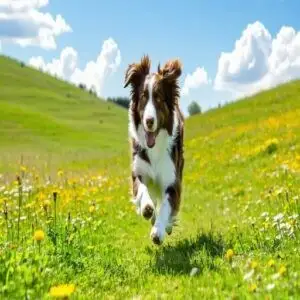This site is supported by our readers. We may earn a commission, at no cost to you, if you purchase through links.
 You might be surprised to learn that several dog breeds are naturally born without tails, thanks to a special genetic mutation called the T-box gene.
You might be surprised to learn that several dog breeds are naturally born without tails, thanks to a special genetic mutation called the T-box gene.
Australian Shepherds, Boston Terriers, and French Bulldogs are among the most popular tailless pups you’ll encounter.
These natural bobtails aren’t missing out – they’ve simply evolved differently!
While some breeds are famous for their docked tails, there’s a big difference between natural bobtails and surgical alterations.
From the hardworking Australian Stumpy Tail Cattle Dog to the charming Brittany Spaniel, these breeds have fascinating stories about how they came to sport their signature stubby look.
Table Of Contents
- Key Takeaways
- Australian Shepherd
- French Bulldogs and Tails
- Rottweilers and Tails
- Boxers and Tails
- Brittany Spaniel and Tails
- Braque Du Bourbonnais and Tails
- Tail Docking: a Painful Practice
- Are All Dogs Born With Tails?
- Evolution of Bobtail Breeds
- Frequently Asked Questions (FAQs)
- What are some popular breeds of dogs that are born without tails?
- What are the benefits of having a dog without a tail?
- Why do some dog breeds not have tails?
- Are there any dogs born without tails?
- What does it mean when a dog is born without tail?
- What happens to dogs without tails?
- What is a tailless dog called?
- Can tailless dogs maintain balance while running or swimming?
- How do tailless puppies interact with tailed dogs?
- Conclusion
Key Takeaways
- You’ll find several dog breeds naturally born without tails due to a T-box gene mutation, including Australian Shepherds, Boston Terriers, and French Bulldogs.
- You won’t need to worry about health issues with naturally tailless dogs, as they’ve evolved to communicate effectively through other body language like facial expressions and posture.
- You can distinguish between natural bobtails and docked tails – while some breeds are born tailless, others have historically undergone tail docking, a controversial practice that’s now banned in several countries.
- You’ll notice tailless dogs adapt well to physical activities, using their legs and core muscles to maintain balance while running or swimming, though they may need extra practice during puppyhood.
Australian Shepherd
You might know Australian Shepherds for their intelligence and agility, but did you know some are naturally born without tails?
This hardworking herding breed comes packed with energy and charm, making them an all-time favorite for active families.
Australian Stumpy Tail Cattle Dog
The Australian Stumpy Tail Cattle Dog is a tailless marvel with brains and bravery to spare.
Perfect for rural livestock work, these natural bobtail dogs are bred for tough tasks and sharp-thinking.
Their stumpy tail genetics make them stand out among working dogs.
- Unbeatable herding instincts – a pro at cattle herding.
- Remarkably intelligent – they love problem-solving.
- Loyal without limits – they’ll stick by your side forever.
Austrian Pinscher
If you admired the Australian Stumpy Tail Cattle Dog’s unique look, meet the Austrian Pinscher, another one of those naturally tailless dogs worth knowing about.
These compact, athletic farm dogs from Austria are all about getting the job done.
With black or grayish-brown coats, perked ears, and a bold, confident vibe, they’ve been keeping farms rat-free since the 19th century.
Known for their spirited personality, Austrian Pinscher temperament strikes a balance between loyal and fearless, though they may give strangers the side-eye.
Pinscher training methods should focus on positive reinforcement to channel their intelligence and energy productively.
Born without tails thanks to genetic tail loss, these natural bobtail dogs embody efficiency and charm wrapped in one feisty package.
Berger De Savoie
Meet the Berger De Savoie, a hardworking Savoy Sheepdog from southeastern France.
Known for its herding skills and natural taillessness, this mountain breed showcases unmatched loyalty.
These bobtailed dogs were raised as versatile farm dogs, tackling tough terrains and shepherd training tasks with ease.
- Adaptable to mountainous regions
- Masters at herding techniques
- Loyal companions on farms
- Naturally tailless heritage
- Beloved among tailless dog species and known for their herding skills
Boston Terrier
The Boston Terrier, a lively tailless dog breed, charms with its tuxedo-like coat, big ears, and natural bobtail.
This cheerful breed, also dubbed the “American Gentleman,” boasts a rich breed history as a bulldog-terrier mix.
Despite their short tail, Boston Temperament shines—friendly, smart, and playful. Terrier Care is simple, thanks to their compact build.
Fun fact: some pups are born with partial tails, but they’re not dogs without tails naturally unhealthy!
Bourbonnais Pointer
If you’re fascinated by tailless dog breeds, the Bourbonnais Pointer deserves your attention.
Originating in 18th-century France, this natural bobtail, also called the Braque du Bourbonnais, stands out with its sleek coat and hunting instincts.
Unlike dogs with tail defects or docked tails, its natural bobtail stems from genetics.
Known for excelling in Pointer training and French hunting traditions, this breed embodies both loyalty and elegance.
Its charm lies in its blend of history and modern breed standards.
French Bulldogs and Tails
French Bulldogs, a beloved natural bobtail breed, are dogs born without tails or with short, stumpy ones thanks to genetic mutations.
This tail structure, shaped by centuries of breed history, was originally intended to reduce tail injuries during bull-baiting.
While adorable, some Frenchies face congenital tail issues like Hemivertebrae, affecting the spine and causing discomfort or weakness.
For more information on french bulldog tail care and characteristics, understanding their breed history is essential.
Since tails play a key role in dog communication, these lovable companions rely on expressive eyes and body language to share their feelings—so keep an eye on those cues!
Rottweilers and Tails
Rottweilers are known for their strong builds and, often, their short tails.
Thanks to Rottweiler genetics, some are naturally born as tailless variants due to the T-box gene mutation found in natural bobtail dog breeds.
However, many Rotties still have their tails docked to meet outdated breed standards, despite this practice being painful and banned in several countries.
Proper tail care products are essential for Rottweilers with tails to prevent health issues, particularly canine tail defects.
A naturally tailless Rottweiler avoids docked dog tails and potential health issues while still mastering canine communication through other body language cues, like posture and expression.
Boxers and Tails
Boxers, known for their playful spirit, aren’t naturally tailless but are often associated with docked tails.
Historically docked for work or aesthetics, many Boxers today proudly keep their full tails, reflecting evolving breed standards.
This shift highlights a growing appreciation for natural bobtail beauty, avoiding unnecessary pain for puppies.
While once claimed to prevent tail injuries, docking can hinder canine communication and balance.
For more information on dog care articles, reflecting on the history and implications of tail docking on breeds like Boxers is necessary.
Embracing their natural tails allows Boxers to wag freely, showcasing their vibrant dog behavior without compromise.
Brittany Spaniel and Tails
The Brittany Spaniel is a standout among tailless dog breeds, thanks to its natural bobtail formed by dominant tail genetics.
These enthusiastic, medium-sized hunters are a blend of determination and charm. Born with varying tail lengths, they’ve embraced diversity since their European origins centuries ago.
Worried about communication? Don’t be—these natural bobtails shine with expressive eyes and friendly energy. For owners seeking Brittany Spaniel products, there are many options available to support their pets.
- Hunt enthusiast? Brittanys excel as sporting dogs.
- Love variety? Tail lengths differ beautifully.
- Concerned about health? They’re robust and low-maintenance.
- Seeking personality? They’re loyal, playful, and keen to please.
Braque Du Bourbonnais and Tails
Ever met a dog that’s as charming as it’s unique?
The Braque Du Bourbonnais, a natural bobtail breed, is one of those.
These dogs born without tails or with short tails owe their distinct look to Bourbonnais Genetics and a fascinating tail mutation.
Tracing its Breed History back to 16th-century France, this tailless dog breed was prized for its hunting skills and loyalty.
Check out this quick overview:
| Feature | Details |
|---|---|
| Origin | Central France (1500s) |
| Unique Trait | Natural Short Bobtail |
| Special Ability | Pointing and Tracking |
Short Tail Care is essential since tails are key to Dog Communication.
With the Braque Du Bourbonnais, you’ll understand emotions through their eyes, ears, and stance!
Tail Docking: a Painful Practice
While some breeds naturally sport shorter tails, tail docking remains a controversial and painful procedure that’s still practiced today.
You’ll find vets removing puppies’ tails as early as 3 days old – a practice that raises serious ethical concerns about canine welfare. Though historically used to protect working dogs from injuries, modern research shows the risks often outweigh any benefits.
The tail docking facts highlight the need for alternative approaches to this outdated practice. From infections to long-term neurological issues, docking can leave lasting impacts on your furry friend.
Many countries now ban this cosmetic surgery, recognizing that a dog’s tail plays an essential role in their well-being.
Are All Dogs Born With Tails?
You might be surprised to learn that not all dogs naturally come with tails.
Thanks to natural breed-specific traits and genetic influences, several dog breeds are born without tails or with naturally short ones.
This unique characteristic comes from a special T-box gene mutation, completely different from tail docking.
When you’re looking at natural tail variations, you’ll spot breeds like the Australian Shepherd, Boston Terrier, and French Bulldog sporting their signature tailless looks.
These dogs face some interesting communication challenges since they can’t wag a tail to show their mood, but they’ve adapted to express themselves through other body language.
For tailless dog breeds, genetic research has provided valuable insights into their development over time.
The health implications of being born without a tail are minimal – these pups are just as happy and healthy as their tailed friends.
It’s fascinating to see how different breeds have developed these traits naturally over time, showing that sometimes the best things in life don’t need a tail end!
Evolution of Bobtail Breeds
Nature’s genetic lottery created an interesting twist in breed development – a single mutation in the T-box gene led to natural bobtail breeds that exist today.
Through genetic drift and natural selection, this trait became more prevalent, with research identifying 48 breeds carrying this distinctive feature.
The mutation’s dominance means just one copy creates a bobtail pup, though breeding two bobtailed dogs can lead to genetic dog disorders.
From the Australian Shepherd’s 20% natural bobtail rate to modern breed development, these ancestral traits show how dogs have evolved without human interference.
Frequently Asked Questions (FAQs)
What are some popular breeds of dogs that are born without tails?
Just like fingerprints, some dogs are uniquely tailless from birth.
You’ll find this natural trait in Australian Shepherds, Boston Terriers, French Bulldogs, and English Bulldogs – each born with their special stumpy signature.
What are the benefits of having a dog without a tail?
You’ll find caring for a tailless pet simpler – no wagging knocks over items, less grooming needed, and fewer vet visits for tail injuries.
They’re also great for small spaces and apartment living.
Why do some dog breeds not have tails?
Picture a genetic game of chance: some breeds naturally lack tails due to a T-box gene mutation called C189G.
It’s like nature’s signature design, creating perfectly tailless pups without any human intervention.
Are there any dogs born without tails?
Yes, several breeds naturally have no tails or very short ones due to genetics.
Look for Australian Shepherds, Boston Terriers, and French Bulldogs if you’re interested in a naturally tailless pup.
What does it mean when a dog is born without tail?
Naturally nifty genetics means you’re looking at a unique mutation in the T-box gene (C189G).
It’s perfectly possible for your furry friend to be born tailless without any health concerns whatsoever.
What happens to dogs without tails?
They’ll rely more on body postures, ear positions, and facial expressions to communicate.
Without tails, they’ll adapt naturally to express emotions differently.
You’ll need to learn their unique body language signals.
What is a tailless dog called?
A bobtail dog is born with a naturally short or absent tail due to a gene mutation.
You’ll commonly find this trait in breeds like Australian Shepherds, French Bulldogs, and Boston Terriers.
Can tailless dogs maintain balance while running or swimming?
Your tailless friend can run and swim just fine.
Dogs adapt well, using their legs, core muscles, and natural agility to stay balanced.
Sure, it might take them extra practice during puppyhood, but they’ll manage perfectly.
How do tailless puppies interact with tailed dogs?
Despite missing a key communication tool, tailless pups learn to read and express body language through other signals.
You’ll notice they adapt quickly, using their whole body to socialize just like their tailed friends.
Conclusion
Whether you’re fascinated by dogs born without tails or considering adding a bobtail breed to your family, these unique pups prove that nature’s diversity is simply amazing.
From the energetic Australian Shepherd to the charming French Bulldog, each breed brings its own special personality to the table.
Now that you understand the genetics behind natural bobtails, you’ll appreciate these tail-free wonders even more.
Remember, a dog’s tail (or lack thereof) is just one part of what makes them extraordinary companions.
- https://pawleaks.com/dogs-born-without-tails/
- https://thebetterdoglife.com/dogs-born-without-tails-the-34-natural-bobtail-breeds/
- https://www.thegoodypet.com/dog-breeds-born-without-tails
- https://www.caringpets.org/dogs/what-dog-breeds-are-born-without-tails/
- https://www.rover.com/uk/blog/dog-breeds-without-tails/













